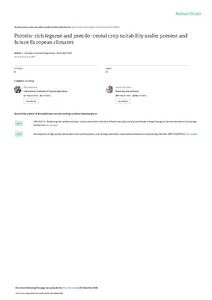| dc.contributor.author | Manners, R. |
| dc.contributor.author | Varela-Ortega, C. |
| dc.contributor.author | van Etten, J. |
| dc.date.accessioned | 2020-08-17T14:04:01Z |
| dc.date.available | 2020-08-17T14:04:01Z |
| dc.date.issued | 2020 |
| dc.identifier.citation | Manners, R., Varela-Ortega, C. & van Etten, J. (2020). Protein-rich legume and pseudo-cereal crop suitability under present and future European climates. European Journal of Agronomy, 113, 1-12. |
| dc.identifier.issn | 1161-0301 |
| dc.identifier.uri | https://hdl.handle.net/20.500.12478/6940 |
| dc.description.abstract | Replacing animal proteins with plant proteins in diets has been demonstrated to have both health and environmental advantages, driving a debate about the potential of protein-rich crops as dietary replacements for animal products. However, there is a lack of knowledge on how climate change could influence the potential for producing protein-rich crops. This study addresses this knowledge gap for the European Union. We analysed 13 protein-rich crops, using the crop suitability model EcoCrop and climate projections for the 2050s, based on 30 Global Circulation Models, under the Representative Concentration Pathway 4.5. The results suggest that current protein-rich crop distributions reflect climatic suitability. We demonstrate the heterogeneous impacts of climate change on crop suitability. In general, conditions in northern Europe were modelled to become more favourable for protein-rich crops, while in southern Europe modelled future climates limit the production of traditional protein-rich crops commonly grown there, including chickpea and lentil. Model results show an expanded area of high suitability for quinoa. Our results confirm the need for concerted breeding and research planning strategies to improve the tolerance of faba bean, lentil, and chickpea to the abiotic stresses that are predicted to become more common with climate change. At the same time, production in northern Europe can benefit from experimentation with protein-rich crops predicted to become more suitable there. Production planning and agricultural policy should consider these likely impacts, to encourage shifts that follow the emerging geographic patterns of crop suitability, and to support the resilience of protein-rich crop production in regions that may be negatively impacted by climate change. |
| dc.description.sponsorship | Universidad Politécnica de Madrid |
| dc.format.extent | 1-12 |
| dc.language.iso | en |
| dc.subject | Proteins |
| dc.subject | Crops |
| dc.subject | Legumes |
| dc.subject | Climate Change |
| dc.subject | Abiotic Stress |
| dc.subject | Cereals |
| dc.subject | Protein Feeds |
| dc.subject | Animal Feed |
| dc.subject | Feeds |
| dc.title | Protein-rich legume and pseudo-cereal crop suitability under present and future European climates |
| dc.type | Journal Article |
| cg.contributor.affiliation | International Institute of Tropical Agriculture |
| cg.contributor.affiliation | Universidad Politécnica de Madrid |
| cg.contributor.affiliation | Bioversity International |
| cg.coverage.region | Europe |
| cg.coverage.hub | Central Africa Hub |
| cg.identifier.bibtexciteid | MANNERS:2020 |
| cg.isijournal | ISI Journal |
| cg.authorship.types | CGIAR and advanced research institute |
| cg.iitasubject | Climate Change |
| cg.iitasubject | Crop Husbandry |
| cg.iitasubject | Crop Systems |
| cg.iitasubject | Food Security |
| cg.iitasubject | Grain Legumes |
| cg.journal | European Journal of Agronomy |
| cg.notes | Open Access Article; Published online: 29 Nov 2019 |
| cg.accessibilitystatus | Open Access |
| cg.reviewstatus | Peer Review |
| cg.usagerightslicense | Creative Commons Attribution 4.0 (CC BY 0.0) |
| cg.targetaudience | Scientists |

